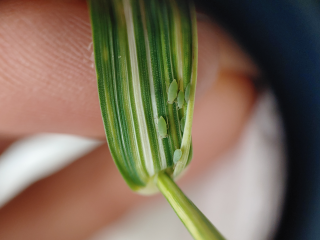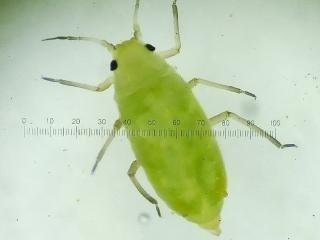Russian wheat aphid
- Dumbleyung
- Fitzgerald
Sophie Daw (South Coastal Agencies) has reported finding low levels of Russian wheat aphid (RWA) feeding damage in tillering barley near Fitzgerald. The crop had not had a seed dressing applied. RWA was not found.
Entomologist Svetlana Micic from the Department of Primary Industries and Regional Development (DPIRD) also recently found RWA feeding damage in an early tillering wheat crop near Dumbleyung, but no RWA were detected in the crop.
Growers are urged to monitor wheat and barley crops, especially those that have not had an insecticide seed dressing and have been late sown for this pest.
How to monitor and diagnose Russian wheat aphid
The three main cereal aphids in WA are corn aphids, oat aphids and the newly introduced RWA. For more information on diagnosing corn and oat aphids, refer to the DPIRD Diagnosing cereal aphids page.
RWA adults are only about two millimetres long, pale yellowish green with a fine waxy coating. RWA antennae are short, as are the cone shaped siphunculi (sometimes called cornicles). A hand lens or smartphone macro lens may be useful to see them. For more information, refer to the DPIRD Diagnosing Russian wheat aphid page.
Start monitoring wheat and barley crops for RWA from GS30. Inspect the edges of crops, as this is where aphids often colonise first, or where plants are under stress. Look for streaking damage near the base of newly emerged leaves.
Unlike other aphids, RWA inject a toxin into the plant that causes:
- a noticeable loss of green colouration across the crop
- white, yellow, purple or red streaking
- leaf curling
- stunted plant growth, and
- loss of vigour in the affected plant.
A few RWA can cause symptoms to appear on plants as early as seven days after infestation. Plant damage symptoms will persist on plants, even if RWA colonies have not survived.
RWA colonies are frequently found on the newest emerged leaves at the base.
Be mindful that RWA damage can look similar to herbicide damage, mite feeding damage or resemble wheat streak mosaic virus symptoms.
Research by DPIRD has found that if seed treatments were not applied, RWA were more likely to be detected on tillers and threshold feeding damage met.
Management
This aphid is readily managed.
Growers are advised to only apply sprays if threshold levels are reached. Researchers from SARDI and Cesar Australia have developed a calculator to help consultants and growers decide if spraying for RWA is economically justified. DPIRD staff tested this calculator in WA conditions in 2022 and found it did accurately predict yield loss for WA crops. It is important to get an accurate assessment of percentage of tillers with RWA, and not use damage symptoms as a measure of RWA presence. For more information on this research, refer to the 2023 Research Updates abstract Russian wheat aphid thresholds in WA and using biological control for RLEM.
For instructions and more information on using the RWA threshold calculator, refer to GRDC’s Russian wheat aphid page.
Aphid colonisation after head emergence in cereal crops does not lead to yield loss.
For a list of insecticides registered for use on aphids (including RWA) see DPIRD’s 2023 winter spring insecticide guide. Refer to the Australian Pesticides and Veterinary Medicines Authority (APVMA) products database for all chemical control options available for RWA in grains crops.
More information
For more information on RWA refer to:
- DPIRD's Russian wheat aphid: production pest page
- Cesar Australia's Russian wheat aphid identification PestBites video
- GRDC's Russian wheat aphid page
- GRDC's Just how many Russian wheat aphids is too many podcast.
For more information on RWA, or other aphids, contact DPIRD Research Scientist Svetlana Micic in Albany on +61 (0)8 9892 8591.
Article authors: Svetlana Micic (DPIRD Albany) and Cindy Webster (DPIRD Narrogin).


